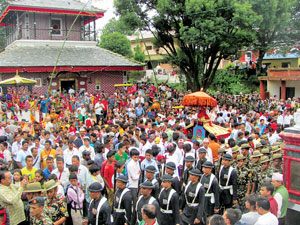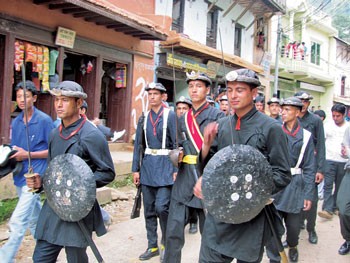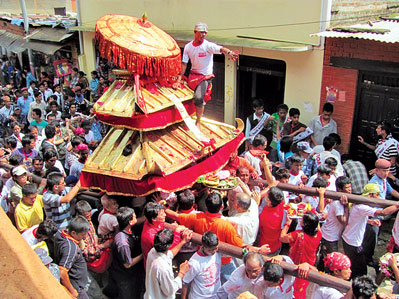
Jatras (festivals) abound in Nepal, but the Khat Jatra is somewhat different from the rest.
Placing deity figures on a khat (wooden platform), and then taking them out in a procession, is known as Khat Jatra, a tradition that has been followed in Kathmandu Valley from the pre-Malla and Malla eras to the Shah era. Along with the campaign of nation-expansion, the custom of Khat Jatra, which was prevalent only in Kathmandu Valley, began to be also observed in other places of the country. Khat Jatra is celebrated in various parts of Palpa, too. Among the khat jatras of Palpa, the one held in Tansen (Bhagwati Jatra) is of a different nature than the rest. While, outwardly, it looks the same as the others, this jatra, in which Goddess Bhagwati’s statue is placed on a khat, is celebrated to commemorate Nepal’s victory in the Palpa region during the Anglo-Nepal War of 1814-1816.
This jatra is not only linked to religion, but also to nationalism. Therefore, this Bhagwati Jatra is not only different from all other jatras of the country, it can be said to be also indifferent. After the annexation of the Sen-era Palpa kingdom into the Kingdom of Nepal, disputes involving Butwal and Syuraj, along with the 22 villages of the east, resulted in war between the East India Company government and the Nepal government. There were many efforts from Nepal’s side to prevent war between the two countries. But, on November 1, 1814, Marcus of Hastings unilaterally declared war on Nepal.
With the objective of disintegrating its enemy’s power base, and gradually weakening its strength, thereby gaining victory over Nepal, the Company government sent forces under Colonel Ochterlony from Rupar so as to gain control over the Sutlej and Jamuna River areas; Major General Robert Rollo Gillespie from Saharanpur, to gain control over Dehradun; Joe Sullivan Wood from Gorakhpur, to control the area starting from Butwal onwards to Palpa; and Captain Major General Bennett Marl from Makwanpur side to attack Kathmandu; while Captain Berry Latter was assigned the responsibility of controlling the area between Kosi and Teesta Rivers in the east.
 From Nepal’s side, too, to counter these war actions, the government ordered forces under the command of Kazi Bakhtar Singh Thapa to Bijayapur in the eastern region; under Colonel Ranbir Singh Thapa to Makwanpur; under Bada Kazi Amar Singh Thapa to the region following Mahakali; and forces under Colonel Ujir Singh Thapa to the Palpa Butwal region. War raged between the two countries. Except for the Palpa region, the war did not go Nepal’s way in other areas. The Company government could gauge the bravery, patience, strategic skills, and battlefield ability of their Nepali adversaries from close quarters in the battle in which they fought under Colonel Ujir Singh Thapa’s leadership.
From Nepal’s side, too, to counter these war actions, the government ordered forces under the command of Kazi Bakhtar Singh Thapa to Bijayapur in the eastern region; under Colonel Ranbir Singh Thapa to Makwanpur; under Bada Kazi Amar Singh Thapa to the region following Mahakali; and forces under Colonel Ujir Singh Thapa to the Palpa Butwal region. War raged between the two countries. Except for the Palpa region, the war did not go Nepal’s way in other areas. The Company government could gauge the bravery, patience, strategic skills, and battlefield ability of their Nepali adversaries from close quarters in the battle in which they fought under Colonel Ujir Singh Thapa’s leadership.
Before entering the battlefield, Colonel Ujir Singh Thapa made suitable arrangements for weapons and ammunition, besides starting construction of roads and bridges and culverts and fortified garrisons on a war footing. In addition, various gods and goddesses were worshipped, and the most auspicious time was determined, so as to ensure victory in battle. And, touching the feet of 16-handed Mahisasur Mardini Bhagwati, located in the middle of Tansen bazaar, Colonel Ujir Singh Thapa also swore, provided that victory was theirs, to build a large temple and spread the goddesses’ fame by conducting a Sindur Jatra all around the region.
A pitched battle followed, in Jitgadhi of Butwal, against the Company government force. Not once, but many, many, times, the defeated Company government forces had to retreat from Nepal. Nepal did not have to lose even an inch of land here. After the victory in this region, Colonel Ujir Singh Thapa, as per his oath, began construction of an impressive three-storied temple in B.S. 1872, which was completed in B.S. 1876. Having donated gold equal to his height for the temple’s gajur, and establishing the silver canopied Mahisasur Mardini Bhagwati, whose 18-arms were made of asta-dhatu (eight-metals, Colonel Ujir Singh Thapa started the Khat Jatra, inclusive of Palpa Bhagwati’s Sindur Jatra, from B.S. 1877, on the day of Bhadra Krishna Nawami. Till today, this Bhagwati Jatra has been traditionally observed as a celebration of victory.
 One day before the jatra, on the night of Krishna Asthami, the local Nepal Army commander places Colonel Ujir Singh Thapa’s offering on the khat in which Bhagwati’s statue has been placed. The next day, at an auspicious time, the judge gives his permission for the rath (chariot) to be lifted, but the rath is lifted only after the Nepal Army has offered its felicitations. The rath is lifted by 48 people, who are called pipas. These lifters, who wear a black tika on their forehead and a scarf tied around the neck, are all from the Kumhal community. After taking the rath three times around the temple, first of all, the Colonel puja is done. Taking the rath out of the main gate, which is considered to be the largest gate in the country, it is taken to the original site of the Palpa durbar, where the Chief District Officer conducts his worship. Only after this is the rath open for worship by all and sundry. According to old-timers, in the years gone by, if some victim of injustice appealed for justice on this day, the rath would move forward only after the concerned individual’s case had been adjudicated by the judge.
One day before the jatra, on the night of Krishna Asthami, the local Nepal Army commander places Colonel Ujir Singh Thapa’s offering on the khat in which Bhagwati’s statue has been placed. The next day, at an auspicious time, the judge gives his permission for the rath (chariot) to be lifted, but the rath is lifted only after the Nepal Army has offered its felicitations. The rath is lifted by 48 people, who are called pipas. These lifters, who wear a black tika on their forehead and a scarf tied around the neck, are all from the Kumhal community. After taking the rath three times around the temple, first of all, the Colonel puja is done. Taking the rath out of the main gate, which is considered to be the largest gate in the country, it is taken to the original site of the Palpa durbar, where the Chief District Officer conducts his worship. Only after this is the rath open for worship by all and sundry. According to old-timers, in the years gone by, if some victim of injustice appealed for justice on this day, the rath would move forward only after the concerned individual’s case had been adjudicated by the judge.
After the rath is paraded around the city, accompanied by musical bands and dancers, as well as soldiers of the Nepal Army, shield and sword carrying soldiers of Gurujyu’s paltan, police personnel, government employees, students, the general public, and various associations and organizations, it enters the Nepal Army barracks, where it is offered a salami before conduct of Bhagwati puja by the Nepal Army. When entering the barrack’s gates, the soldiers themselves lift the rath on their shoulders.
 Another basic aspect of this jatra is the arrangement of a regular priest to conduct daily rituals and worship in the temple. The priest has to be someone with the knowledge of conducting rituals associated with Matri Mandali of the Devi’s temple according to Hindu rites and rituals. Two hundred years ago, Colonel Ujir Singh Thapa had brought in Chandramani Gubhaju of Mayur Varna Vihar, Lalitpur, to Palpa, to conduct Nitya-naumaitik puja and Barsha Bandhan puja (karak puja), and tantric rituals and worship during Kalaratri Asthami and Chaite Dashain, etc. The descendants of this very same Gubhaju have been conducting worship in this temple till date.
Another basic aspect of this jatra is the arrangement of a regular priest to conduct daily rituals and worship in the temple. The priest has to be someone with the knowledge of conducting rituals associated with Matri Mandali of the Devi’s temple according to Hindu rites and rituals. Two hundred years ago, Colonel Ujir Singh Thapa had brought in Chandramani Gubhaju of Mayur Varna Vihar, Lalitpur, to Palpa, to conduct Nitya-naumaitik puja and Barsha Bandhan puja (karak puja), and tantric rituals and worship during Kalaratri Asthami and Chaite Dashain, etc. The descendants of this very same Gubhaju have been conducting worship in this temple till date.
This Palpa Bhagwati Jatra, considered to be the symbol of bravery, patience, strategic skill, patriotism, and victory, has always been bringing nationalism to the forefrongt.











